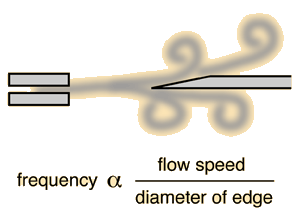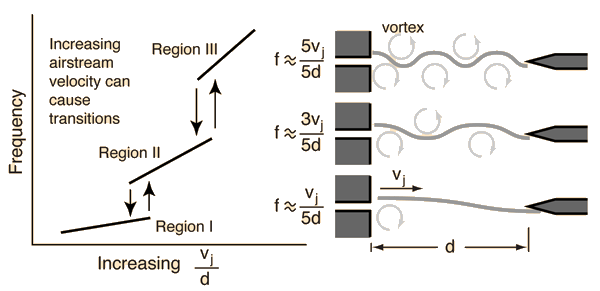Oscillations at a Free Edge
|
If you directed air or a liquid toward a sharp edge, you might expect it to divide evenly and smoothly at the edge. But nature doesn't behave that way. You tend to get oscillations of the flow back and forth across the edge. This has long been associated with the the formation of swirls or vortices in the flow. It is observed that the frequency of the oscillation tends to go up linearly with the flow velocity, but that the frequency for a larger diameter "edge" is lower. |  |
This fluid driven oscillation is observed in a wide variety of settings. One of the most familiar is the singing of tightly stretched electric wires in the wind. My wife and I lived in North Wales for a year and heard this sound daily. Outside the bedroom of our third floor "flat" was a thin, tightly stretched electric wire which was constantly exposed to the wind off the Menai Strait. We awoke every morning to the sound of the wire singing in the wind, so we had an instant weather report since a higher pitch meant higher wind speed. Our common line was "The wire is up to an F this morning! Let's stay in bed!"
Other common examples of fluid-driven oscillations:
- The strap you use to tie a load on a pickup truck will vibrate in the wind. Often you can see examples of the fundamental string mode of vibration in a tightly stretched strap in the wind.
- If you tried to use plastic to cover the load described above, you find out that any exposed edge of the plastic will oscillate wildly in the wind, so that it is hard to keep a load covered if any edges are exposed. Corners of a cover or loose ends of a strap will flap so wildly that they tend to fray.
- A flag on a flagpole will flutter in the wind. A steady wind will generate a rapid fluttering of the cloth of the flag.
- A kite in the wind demonstrates the diameter dependence of the fluid-induced oscillation. The kite material will flutter rapidly from the component of wind directed toward its edge, but will also bob slowly back and forth in the wind, presumably from the component of wind directed toward the full area of the kite. Acting as a larger barrier, the body of the kite experiences a slower oscillation.
- If you dip your fingers in water and move your hand quickly through the water, your fingers will beat together, presumably because of fluid-induced oscillation.
- Direct the stream of a hose on a twig or stalk. If you hold the stream steady, you will observe the twig to start an oscillation back and forth in the stream.
- A fluid oscillation you can feel is in the experience of mounting a slalom water ski. As the ski breaks the surface of the water and begins to plow through the water, it will begin to oscillate back and forth. That's when you usually fall! If you make it through the oscillation period and get the ski up on a plane, it ceases to oscillate.
If you blow with increasing air stream velocity on a whistle composed of a slit and an edge, you will note that you get jumps in pitch and experience several ranges of edgetones. Associated with the vortices in the flow, there are several regimes of edge tones . The illustration below is adapted from Hall, who references the work of Coltman. It associated the different edgetone regimes with patterns of vortex formation and feedback to the slit from the edge.

| Edge tone |
References
Hall
Ch 12
Coltman
JASA 1976